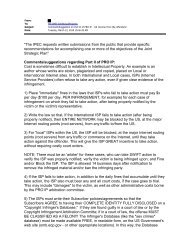We Energies Coal Combustion Products ... - The White House
We Energies Coal Combustion Products ... - The White House
We Energies Coal Combustion Products ... - The White House
You also want an ePaper? Increase the reach of your titles
YUMPU automatically turns print PDFs into web optimized ePapers that Google loves.
<strong>The</strong> project scope included construction of a reinforced concrete pipe culvert.<br />
<strong>The</strong> contractor completed this task prior to starting the paving. <strong>The</strong> base<br />
course of the pavement section at the culvert for a length of approximately 50<br />
feet was constructed using crushed aggregate, instead of fly ash stabilized CIR<br />
materials. Prior to construction of the road, undercutting was performed at<br />
places where severe pavement distresses existed. <strong>The</strong> pavement was<br />
excavated to a depth of 2 feet underneath the existing base course and was<br />
filled with breaker run stone. Initial pulverization started on October 9, 2001.<br />
<strong>The</strong> existing HMA pavement was first pulverized to a depth of 5”. After<br />
spraying water on the surface of pulverized materials, the pavement was<br />
repulverized to a depth of 12” and was graded and compacted by a Sheep’s<br />
Foot Roller.<br />
Fly ash was placed on October 11, 2001. Fly ash was transferred from the<br />
supply tanker to the vein feeder spreader truck through a hose, which<br />
significantly reduced dusting. <strong>The</strong> vein feeder spreader truck applied the fly<br />
ash at an application rate of 8% by weight. <strong>The</strong> feed gates from the spreader<br />
truck provided a six ft. wide surface application. Water was sprayed to obtain<br />
the water content of the stabilized CIR materials to the desired 5.0% moisture<br />
content. <strong>The</strong> fly ash and moisture content was controlled by an operator, based<br />
on field experience. <strong>The</strong> mixing operation commenced immediately after<br />
distribution of fly ash over a length of approximately 100 feet and was<br />
completed within one hour, using the pulverizer. Compaction of the mixture<br />
began immediately after mixing and was completed within one hour following<br />
spreading of fly ash. <strong>The</strong> compaction of the base course included 6 passes of<br />
the Sheep’s Foot Roller followed by 2 passes of the Vibratory Drum<br />
Compactor.<br />
A laboratory mix analysis to evaluate the stabilization potential of recycled<br />
pavement material with Class C fly ash was conducted. A field sample of<br />
existing asphalt pavement and underlying aggregate bases was obtained from<br />
CTH JK. <strong>The</strong> results of the grain size analysis on the CIR material indicated a<br />
sand and gravel mixture with trace fines. <strong>The</strong> analysis showed that the sample<br />
contained 68% gravel (larger than #4 sieve), 26% sand (between #4 and #200<br />
sieves) and 6% silt (between #200 sieve and size of 0.005 mm) and clay<br />
(between 0.005 and 0.001 mm) size particles. Evaluation of fly ash stabilized<br />
CIR material was performed at two fly ash contents, 6% and 8% by dry<br />
weight of total mix. Laboratory analysis of the fly ash stabilized materials was<br />
in accordance with ASTM C593, where the Moisture-Density (ASTM D1557)<br />
and Moisture-Strength (ASTM D1633) relationship of specimens compacted<br />
in a 4” diameter mold was obtained. Results of the moisture density<br />
relationship test on the recycled asphalt pavement indicated a maximum dry<br />
density of 141.7 pcf at an optimum moisture level of 5.0%. In addition,<br />
moisture density relationship tests on the recycled asphalt pavement material<br />
with 6%and 8% fly ash added indicated a maximum dry density of 142.3 and<br />
142.9 pcf at optimum moisture contents of 5.5%, respectively. A maximum<br />
<strong>We</strong> <strong>Energies</strong> 190<br />
<strong>Coal</strong> <strong>Combustion</strong> <strong>Products</strong><br />
Utilization Handbook



